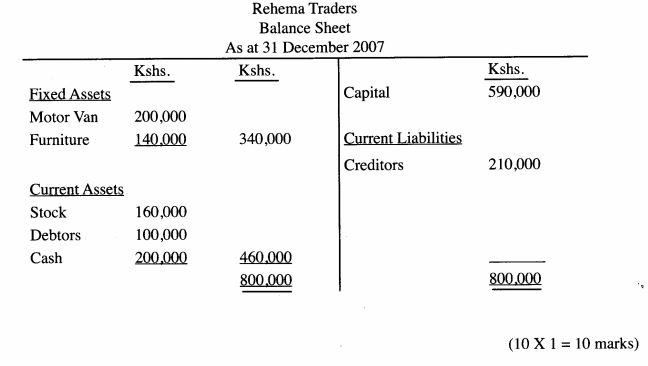2011 KCSE Business Studies Past Paper
KCSE Past Papers Business Studies 2011
5.5.1 Business Studies Paper 1 (565/1)
1 Identify the types of wholesalers described in the statements given below: (4 marks)
(a) A wholesaler who trades in maize grain only.
(b) A wholesaler who supplies goods to most of the traders in Kitui, Mbooni and Machakos districts in the Eastern part of Kenya.
(c) A wholesaler who buys tomatoes from farmers in rural areas and sells the same to other wholesalers in urban areas.
(d) A wholesaler who trades in a wide variety of human medicine.
2 Outline four factors that should be considered before buying office equipment. (4 marks)
(a)…………….
(b)…………….
(c)…………….
(d)…………….
3 Outline four malpractices by traders against which consumers may need protection by the government. (4 marks)
(a) …………….
(b)…………….
(C)…………….
(d)…………….
4 State three features of an insurable interest. (3 marks)
(a) …………………
(b) .. ……………..
(c) ………………..
5 Outline four ways of reducing the level of unemployment in Kenya.(4 marks)
(a)………………..
(b)………………..
(c)………………..
(d)………………..
6 State four services offered by a commercial bank to its consumers.(4 marks)
(a)………………..
(b)………………..
(c)………………..
(d)………………..
7 List four sources of public finance.(4 marks)
(a)………………..
(b)………………..
(C)………………..
(d)………………..
8 Outline four reasons why countries may trade with each other.(4 marks)
(a)………………..
(b)………………..
(c)………………..
(d)………………..
9 State four reasons why economic development is desirable to a country.(4 marks)
(a)………………..
(b)………………..
(c)………………..
(d)………………..
10 Indicate the reward associated with each of the factors of production in the table below. (4 marks)

11 Outline four circumstances under which a co-operative society may be dissolved. (4 marks) (a) ……………………….
(b) ………………………
(c) ………………………
(d) ………………………
12 Highlight four features of a bonded warehouse. (4 marks)
(a) ……………………….
(b) ……………………….
(c)……………………….
(d) ……………………….
13 Outline four factors that may be considered when measuring the size of a firm. (4 marks)
(a) ………………………..
(b) …………………………
(c) ………………………….
(d) ………………………….
14 The following transactions were extracted from the books of Sarah Traders for the month of March 2006. March l0: Purchased goods on credit worth Ksh 200 ,00O from Salim Traders March 25: Sold goods on credit worth Ksh 420,000 to Shah Traders Record the above transactions in the ledger accounts below: (4 marks)
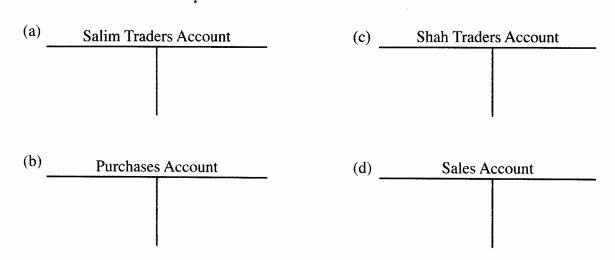
15 On 2″“ November 2006, Oromo received an invoice for Ksh 12,000. Terms of payment were trade discount 5% and cash discount 10%, if payment is made Within 30 days. Determine the amount paid if payment was made on 28th November 2006. (4 marks)
16 The following balances were extracted from the books of Nafula Traders as at 31st December 2005.
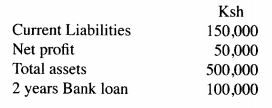
Calculate the rate of return on capital. (4 marks)
17 The information given below was extracted from the books of Amina Traders on 31st December 2006.
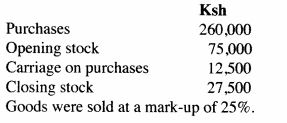
Using the information given above, prepare Amina Traders’ Trading Account. (4 marks)
18 State four benefits that a farmer may get by transporting produce to the market by road. (4 marks)
(a) .. ………………………
(b) …………………………
(c) …………………………
(d) ………………………..
19 The table given below represents the supply schedule of sukuma wiki (kales) for eight weeks in the months of January and February 2009.

Outline four causes of the trend in the table. (4 marks)
(a)………………………..
(b)………………………..
(c)………………………..
(d)………………………..
20 Outline four ways in which households contribute to national income of a country. (4 marks)
(a)………………………..
(b)………………………..
(c)………………………..
(d)………………………..
21 Outline four circumstances in which a trader may use oral communication. (4 marks)
(a)………………………..
(b)………………………..
(c)………………………..
(d)………………………..
22 Outline four reasons why a firm may remain small. (4 marks)
(a)………………………..
(b)………………………..
(c)………………………..
(c)………………………..
23 On lst January 2007, Muthoni Traders Cash Book showed a credit balance of Ksh 150,000 at the bank and a debit balance of Ksh 25,250 in hand. During the month, the following transactions took place:
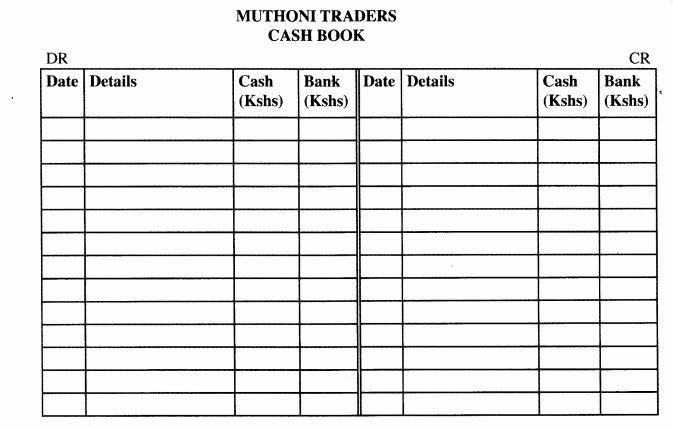
24 State four benefits that a trader may get by advertising products in a newspaper. (4 marks)
(a) …………………………
(b) …………………………
(c) …………………………
(d) ………………………..
5.5.2 Business Studies Paper 2 (565/2)
1 (a) Explain the following types of inflation:
(i) demand-pull inflation
(ii) cost-push inflation
(ii) imported inflation
(iv) structural. inflation. (8 marks)
(b) Explain six factors that may hinder the development of a country. (12 marks)
2 (a) Explain circumstances under which containerization may be used to transport goods. (10 marks)
(b) (i) Explain the procedure for making an insurance claim. (5 marks)
(ii) A farmer’s house valued at Ksh. l,200,000 was insured against fire for Ksh. 900,000 under the “with average clause”. Fire occurred and damaged the house causing a loss of Ksh. 500,000. Determine the value of compensation due to the farmer. ‘ (5 marks)
3 (a) Discuss product.
factors that may be considered when choosing a method for promoting a (10 marks)
(b) Describe features of economic resources. (10 marks)
4 (a) Explain benefits that may accrue to an organization that adopts an open office plan. (10 marks)
(b) Discuss circumstances under which a partnership may be dissolved. (10 marks)
5 (a) Amboseli Roses is a horticultural company producing flowers. Explain six factors that may influence the choice of a channel for distributing its products. (12 marks)
(b) Give reasons for maintaining books of original entry. (8 marks)
6 (a)Discuss causes of unfavourable balance of payment for most developing countries. (10 marks)
(b) The following balances were extracted from the books of Rehema Traders on 1st January 2007
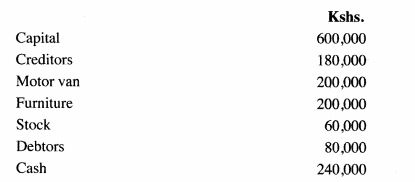
The following transactions took place during the year ended 31 st December, 2007 (i) Sold furniture worth Ksh. 60,000 for which Ksh. 40,000 cash was received and the balance was due at the end of the year.
(ii) Purchased goods Worth Ksh.100,000 for which cash of Ksh. 70,000 was paid and the balance was still outstanding at the end of the year.
(iii) Cash Ksh. 10,000 was taken from the business by the proprietor to settle the spouse’s hospital bill.
Required: Dmw Rehema Trader‘s balance sheet as at 31st December, 2007 showing the items in their relevant classes. (10 marks)
2011 KCSE Business Studies-Marking Scheme/Answers
1 Types of wholesalers
(a) Specialized wholesaler
(b) Regional wholesaler
(c) Rack jobbers
(d) General line wholesaler (4 X 1 mark = 4 marks)
2 Factors to consider before buying office equipment include:
(a) space available
(b) use of which it be put
(c) technological trends in the industry
(d) funds available
(e) skills available
(Any 4 x l mark = 4 marks)
3 Malpractices by traders against which consumers may need protection by the government include:
(a) selling of contraband goods
(b) overcharging
(c) selling under Weight goods
(d) selling expired goods
(e) giving misleading information about the product
(f) hoarding
(Any 4 x l mark : 4 marks)
4 Features of insurable interest include:
(a) presence of property rights or interest
(b) potential insurable risk must be present
(c) the property must have monetary value
(d) the insurable risk must be legal
(e) there must be the possibility of suffering financial loss in case of a risk happening (Any 3 x 1 = 3 marks)
5 Ways of reducing the level of unemployment in Kenya include:
(a) encouraging self-employment
(b) establishment of more labour intensive industries
(c) impart the right skills through education and training
(d) expanding the market for agricultural goods
(e) exporting surplus manpower
(Any 4 X 1 mark = 4 marks)
6 Services offered by a commercial bank to its customers include:
(a) acceptance of deposits
(b) safeguarding valuable items
(c) advancing loans
(d) offering management and consultancy services
(e) advisory services on financial matters
(f) foreign exchange services
(Any 4 x l mark = 4 marks)
7 Sources of public finance include:
(a) taxes
(b) licences
(c) court fines
(d) donor aid
(e) fees
(f) treasury bonds and bills
8 Reasons why countries may trade with each other include:
(a) to sell their surplus
(b) to enhance bilateral ties
(c) to acquire what they are not able to produce
(d) protect special interest
(f) to improve the quality of life of their citizens/improve access to a variety of goods improve standard of living of the citizens
(Any 4 x 1 mark = 4 marks)
9 Reasons Why economic development is desirable to a country include:
(a) improve infrastructure
(b) create employment
(c) increase life expectancy
(d) reduce rural-urban disparity
(e) improve the social welfare of citizens
(Any 4 x l mark = 4 marks)
10 Factors of production and rewards they earn:
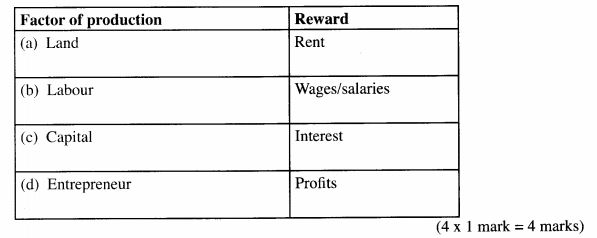
(Any 4 x 1 mark = 4 marks)
11 Circumstances under which a co~operative society may be dissolved include:
(a) by Government order
(b) Where the co-operative continuously make losses
(c) Where stipulated majority of members agree to dissolve it
(d) by a court order
(e) Where the co-operative society has achieved objectives for which it was formed
12 Features of a bonded warehouse include:
(a) mostly located at points of entry into a country like the ports
(b) stores goods that are under bond
(c) guarantees payment of customs duty to customs authority
(d) very spacious to accommodate even bulky goods like motor vehicles
(e) must issue release Warrants to owners of goods for customs clearance
(f) works hand in hand with customs officials for inspection of goods
(Any 4 X 1 mark = 4 marks
13 Factors that may be considered when measuring the size of a firm include:
(a) the level or volume of output
(b) the number of employees
(c) the capital invested
(d) the production methods (technology) used
(e) the market served
(f) the floor area covered by the firm’s
(h) the sales volume
14
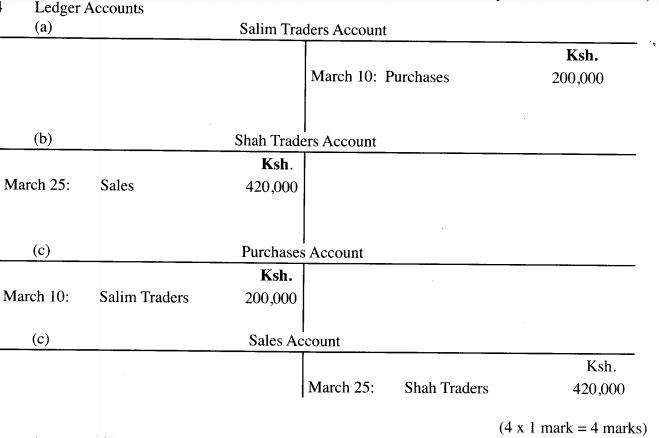
15

16 Calculation of rate of return on capital
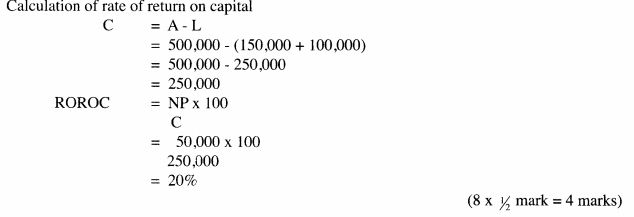
17
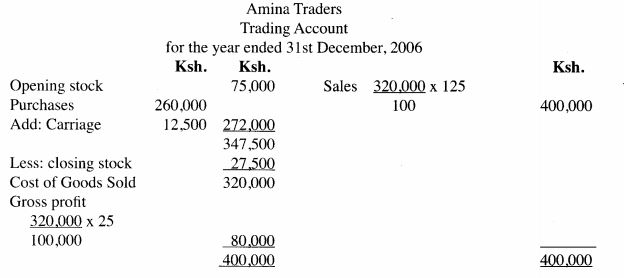
18 Benefits that a farmer may get by transporting her produce to the market by road include:
(a) Relatively flexible
(b) Relatively cheap
(c) Relatively available
(d) Relatively fast
(e) Variety of means of road transport
(Any 4 x 1 mark = 4 marks)
19 Causes of the declining supply of sukuma wiki include:
(a) fall in the price of kales (sukuma wiki) may have discouraged producers (farmers) as they opt to produce other goods
(b) there may have been an outbreak of diseases affecting the sukuma wiki
(c) there may have been prolonged drought which affects the sukuma wiki
(d) there may have been increased cost of farm inputs like fertilizer and seeds
(e) the farmers could be using inappropriate technology to produce the sukuma wiki
(f) this may just be the ploughing time and many farmers have not yet planted sukuma wiki
(Any 4 x 1 = 4 marks)
20 Ways in which households may contribute to national income of a country include:
(a) consumption of goods ~
(b) payment of taxes
(c) provision of factors of production
(d) provision of savings for investment
21 Circumstances in which a trader may use oral communication include
(a) when there is need to negotiate a deal
(b) when there is need to explain the use and features of a product
(c) when there is need for immediate feedback
(d) when there is need to give an immediate compliment
(e) when selling over the counter
22 Reasons why a firm may remain small include:
(a) Target market is small
(b) Limited production capacity
(c) Nature of the product
(d) Owner’s decision to remain small
(f) Inadequate appropriate technology
23 Two-column cash book for the month of January
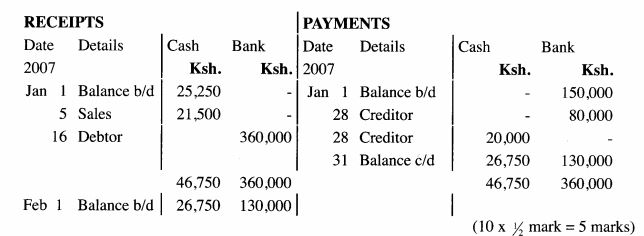
24 Benefits that accme to a trader who advertises products in a newspaper include:
(a) wide coverage – message can reach a lot of people
(b) evidence of the message exists
(c) graphical details can be included
(d) a traderhas a chance to compete with other traders
(e) a trader has a chance of increasing sales.
25 Calculation of the increase in consumer price index
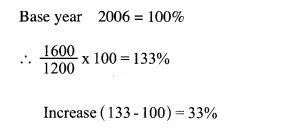
(4 x 1 mark = 4 marks)
33.2 Business Studies Paper 2 (565/2)
1. (a) Explaining the types of inflation
(i) Demand-Pull inflation
Refers to a progressive increase in the general level of prices brought about by an expansion in demand. There is too much money chasing very few goods.
(ii) Cost-Push inflation
A progressive increase in the general price level brought about by a general increase in the cost of production.
(iii) Imported inflation
Refers to an increase in domestic prices resulting from importation of primary goods and inputs at higher prices.
(iv) Structural inflation
Refers to a persistent rise in prices resulting from failure of the economy to meet the general increase in demand.
(4 x 2 = 8 marks)
(b) Factors that may hinder the development of a country include:
(i) Low demand for goods and services which discourages production activities hence interfering with development.
(ii) Inadequate capital which leads to low levels of development
(iii) Negative sociocultural practices which may hinder production and consumption of certain goods and services.
(iv) Inadequate foreign exchange which limits access to imports hence affecting production and consumption.
(v) Limited entrepreneurial abilities resulting into inefficiency in production.
(vi) Poor management of resources arising from inadequate skills, corruption and poor govemance which limit the extent of growth and development.
(vii) Poor nutrition and disease prevalence which renders some of the people unproductive as well as channelling much of the income into provision of health care instead of investment.
(viii) Use of inappropriate technology which compromises the quantity and quality of goods and services produced.
(Any 6 x 2 = 12 marks)
2. (a) Circumstances under which containerization may be used to transport goods include:
(i) Where bulky goods are imported. Bulky goods are usually transported by sea where containers are used.
(ii) Where specialized equipment are available for handling containers.
(iii) Where container terminals are available – containerization require container terminals which are specially built to handle them.
(iv) Where specialized means of transport like railways are available.
(v) Where security of goods need to be guaranteed. Goods of very high value and those that are risky require high level of security which is guaranteed by containers.
(vi) Where skilled personnel are available. The handling of containers require specially trained workers to handle and manage them.
(Any 5 x 2 = 10 marks)
(b) (I) Procedure for making an insurance claim
(i) Notifying the insurer of the loss suffered.
(ii) Filling a claim form from the insurer.
(iii) Carrying out investigation to determine or ascertain the cause of loss.
(iv) Insurance company making a report.
(v) Determination and payment of the claim.
(5 X 1 = 5 marks)
(II) Determination of compensation

3. (a) Factors to consider when choosing a method of promoting a product include:
(i) Cost of the method. The organization should choose a promotion method that is affordable.
(ii) Geographical area of coverage. The organization should choose a method that will reach the customers in their various locations.
(iii) Target group. The organization must choose a method that appeals to the relevant target group.
(iv) Speed of the medium or method in relation to urgency of the message. The organization should choose a method that will reach the customers within the desired time frame.
(v) Nature of the product. Different methods may be chosen depending on the nature of the product e.g. technical products may require demonstrations best achieved through personal selling.
(vi) Nature of the message. The organization should choose a method that will best present the various aspects of the message.
(Any 5 x 2 = 10 marks)
(b) Features of economic resources include:
(i) Scarcity. They are found in small quantities compared to the many uses into which they have to be put and hence not sufficient to satisfy all human wants.
(ii) Monetary Value. They have a price attached to them which have to be paid for their use.
(iii) Uneven distribution. They are not distributed uniformly in society, hence some people, regions or countries have more of the resources than others.
(iv) Combinability. They can be used in different proportions to produce goods and services.
(v) Usefulness. They are used to satisfy human wants (have utility).
(vi) Transferability. They may be transferred from one person to another in terms of ownership.
(Any 5 x 2 = 10 marks)
4 (a) Benefits that may accrue to an organization that adopts an open office plan include:
(i)Easy supervision. It is easy to monitor employee’s perfonnance since they are in the same room.
(ii) Economy of space. More floor space is available since space has not been lost through partitions.
(iii) Minimal cost. It is cheap to construct and maintain.
(iv) Sharing of resources. It makes possible for joint use of office facilities.
(v) Easy communication. Communication between workers and departments is made easier and faster since there are no physical barriers between them.
(v) Easy reorganization. It is easy to re-arrange the office when need arises.
(vi) Enhanced teamwork. Employees work as a team and learn to be together.
(Any 5 x 2 = 10 marks)
(b) Circumstances under which a partnership may be dissolved include:
(i)Expiry of time or accomplishment of purpose. Where the partnership was formed for a definite time or a particular purpose, the expiry of time and accomplishment of purpose terminates the partnership.
(ii) Mutual agreement among partners – where the partners agree among themselves to terminate the partnership.
(iii) Bankruptcy of a general partner – where a court declares the value of one of the general partner’s property insufficient to settle his or her debts.
(iv) Change in law that makes the operations of the partnership illegal.
(v) Permanent inability of a general partner to perform or fulfill his part of the partnership agreement either as a result of disease, insanity or death.
(vi) Internal dissension among partners – where partners disagree irreconcilably, then the partnership may be terminated.
(vii) Persistent losses in operation – where the business has continued to operate at a loss, then it is terminated.
(v) Fraud, mistake or misrepresentation – where the partnership was formed under fraud, mistake or misrepresentation, a Court of Law may order its dissolution.
(Any 5 x 2 = 10 marks)
5 (a) Factors that may influence the choice of a channel for distributing flowers include:
(i) Nature of the flowers – flowers are perishable and therefore need a short channel in order to be distributed quickly.
(ii) Cost. The cost of different channels of distribution should be considered and the cheapest channel used.
(iii) Nature of the market. If consumers are widespread, then agents may be necessary to reach them.
(iv) Tastes and preferences of consumers. Consumers may have specific preferences which might require the personal attention of the producer hence use of a shorter channel.
(v) Competition. Where competition is high, the producer will have to close to the consumers and will therefore use a short channel of distribution.
(vi) Quantity. If the quantity of flowers to be sold is large. then more middlemen may be required.
(vii) Availability of technical personnel. If the producer does not have the required technical personnel, then he may have to use a longer channel.
(Any 6 x 2 = 12 marks)
(b) Reasons for maintaining books of original entry include:
(i) To reduce details to be recorded in the ledger accounts.
(ii) Act as back-up data from which other information may be extracted if need arise.
(iii) Contain information which act as reference such as units, trade discounts and terms of sale.
(iv) The general journal is used to correct errors made when recording transactions.
(v) The three-column cash book is used as a book of original entry as well as a i ledger.
(Any 4 x 2 = 8 marks)
6. (a) Causes of unfavorable balance of payment for most developing countries include:
(i) Reliance on primary products for export. Most developing countries mainly export primary agricultural products which fetch low prices in the international market.
(ii) Heavy importation of finished goods. Most developing countries import finished manufactured goods whose value are very high hence spend more on them.
(iii) Low levels of technology. Most developing countries rely on low levels of technology in production which compromises the quality of their exports and also lowering their value.
(iv) Too much reliance on foreign borrowing. Most developing countries finance their development projects through heavy borrowing yet such loans are repaid with heavy interests.
(v) Susceptibility to natural calamities. Many developing countries are easily affected by natural disasters like drought which adversely affect their production.
(vi) Preference towards foreign goods. Most consumers in developing countries prefer goods manufactured in foreign countries in the belief that they are of better quality.
(vii) Unfavourable world economic order. The developing countries have very little say in international trade forums and cannot influence the world economic order in their favour.
(Any 5 x 2 =10 marks
(b)
